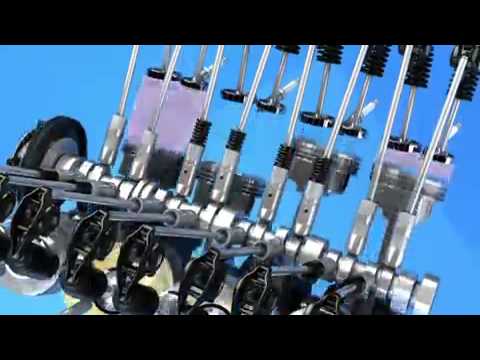: Unraveling the Mystery of the Firing Order in the 5.3L Engine

In the realm of internal combustion engines, the firing order is a crucial element that determines the sequence in which the engine’s cylinders receive ignition. Among the myriad of engines in existence, the 5.3L engine stands out as a workhorse, powering a variety of vehicles. This article delves into the intricacies of the firing order in the 5.3L engine, unraveling the mystery behind its sequence and exploring the implications for performance.
Understanding Firing Order
The firing order refers to the specific sequence in which the spark plugs in an engine’s cylinders are ignited. This sequence is essential for maintaining proper engine balance, ensuring smooth operation, and optimizing performance. In the context of the 5.3L engine, this order dictates the timing at which fuel is ignited, resulting in the controlled combustion necessary for generating power.
The 5.3L Engine: A Powerhouse
The 5.3L engine has become synonymous with power and efficiency, finding its home in a diverse range of vehicles, from trucks to SUVs. Manufactured by General Motors (GM), this engine has earned a reputation for its robust design and versatile performance across various applications.
Firing Order in the 5.3L Engine
The 5.3L engine follows a specific firing order to ensure optimal performance and efficiency. In this engine, the firing order is 1-8-7-2-6-5-4-3, which signifies the order in which each cylinder receives ignition. Breaking it down, cylinder 1 is ignited first, followed by cylinder 8, and so on, until the sequence repeats.
Implications for Engine Balance
The firing order is not arbitrary; it is carefully designed to achieve balanced engine operation. The precise timing of ignition prevents uneven forces acting on the crankshaft, minimizing vibrations and ensuring a smoother running engine. This balance is crucial for the longevity of the engine, reducing wear and tear on components.
Performance Considerations
The firing order of the 5.3L engine contributes significantly to its overall performance. By optimizing the ignition sequence, engineers can fine-tune the engine to deliver the ideal balance of power, fuel efficiency, and smooth operation. This is especially critical in applications such as trucks and SUVs, where a consistent and reliable power delivery is paramount.
The Role of the Distributor
In older engine designs, a distributor played a crucial role in delivering the spark to the correct cylinder at the right time. However, modern engines, including the 5.3L, often use electronic ignition systems that eliminate the need for a traditional distributor. Instead, coil-on-plug or coil-near-plug systems deliver precise spark timing directly to each cylinder.
Benefits of Modern Ignition Systems
Electronic ignition systems offer several advantages over traditional distributors. They allow for more precise control of ignition timing, enabling engineers to optimize performance and fuel efficiency. Additionally, these systems are more reliable and require less maintenance, contributing to the overall durability of the engine.
Tuning Possibilities
Enthusiasts and professional tuners often explore the tuning possibilities that the firing order provides. By adjusting ignition timing and fuel delivery, tuners can fine-tune the engine’s performance characteristics to meet specific requirements. This flexibility is particularly relevant in performance-oriented applications, where squeezing every ounce of power from the engine is a priority.
Common Issues and Troubleshooting
Understanding the firing order is essential when diagnosing and troubleshooting engine issues. Misfires, rough idling, or reduced performance can often be linked to problems with the ignition system. Knowledge of the firing order helps mechanics pinpoint the cylinder causing the issue and facilitates a more efficient and accurate resolution.
Conclusion
In the world of internal combustion engines, the firing order is a fundamental aspect that influences performance, efficiency, and engine balance. The 5.3L engine, with its versatile applications, relies on a specific firing order to deliver the power and reliability for which it is renowned. As automotive technology continues to evolve, the firing order remains a critical parameter that engineers and enthusiasts alike consider in the pursuit of optimal engine performance. Understanding the intricacies of the firing order in the 5.3L engine sheds light on the engineering marvel that powers a myriad of vehicles on roads today.
Q1: What is the firing order of the 5.3L engine? A1: The firing order of the 5.3L engine is 1-8-7-2-6-5-4-3. This sequence represents the order in which each cylinder receives ignition.
Q2: Why is the firing order important in an engine? A2: The firing order is crucial for maintaining engine balance, minimizing vibrations, and ensuring smooth operation. It dictates the sequence in which spark plugs are ignited, influencing the timing of fuel combustion in each cylinder.
Q3: How does the firing order impact engine performance? A3: The firing order directly affects the engine’s performance by optimizing the timing of ignition. This optimization contributes to a balanced power delivery, fuel efficiency, and overall smooth operation.
Q4: What role does the firing order play in reducing engine vibrations? A4: The firing order is designed to distribute the forces acting on the crankshaft evenly, reducing vibrations. This balanced operation minimizes wear and tear on engine components and enhances overall durability.
Q5: Does the 5.3L engine use a distributor for ignition? A5: No, modern 5.3L engines typically use electronic ignition systems, eliminating the need for a traditional distributor. Coil-on-plug or coil-near-plug systems deliver precise spark timing to each cylinder.
Q6: How can the firing order be relevant in engine tuning? A6: Enthusiasts and tuners can leverage the firing order for engine tuning. By adjusting ignition timing and fuel delivery, tuners can fine-tune performance characteristics to meet specific requirements in various applications.
Q7: Are there common issues related to the firing order in the 5.3L engine? A7: Issues such as misfires, rough idling, or reduced performance can be linked to problems with the ignition system, including the firing order. Knowledge of the firing order is valuable in diagnosing and troubleshooting these issues efficiently.
Q8: Can the firing order impact fuel efficiency? A8: Yes, the firing order contributes to fuel efficiency by influencing the timing of combustion. Properly timed ignition ensures efficient burning of fuel, optimizing the engine’s overall fuel efficiency.
Q9: How has technology influenced the firing order in modern engines? A9: Electronic ignition systems in modern engines, including the 5.3L, have replaced traditional distributors. This technology allows for more precise control of ignition timing, enhancing overall engine performance and reliability.
Q10: Is the firing order specific to the 5.3L engine, or do other engines have different orders? A10: Firing orders are engine-specific, and different engines may have distinct firing sequences. The 5.3L engine’s firing order (1-8-7-2-6-5-4-3) is unique to its design and application.





